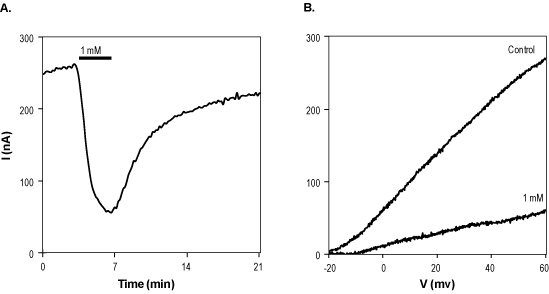Overview
- Perreault, P. et al. (1991) J. Neurophysiol. 65, 771.
- Stephens, G.J. et al. (1994) J. Physiol. 477, 187.
- Kirsch, G.E. et al. (1993) Neuron 11, 503.
 Alomone Labs 4-Aminopyridine blocks KV1.2 channel currents heterologously expressed in Xenopus oocytes.A. Time course of current reversible inhibition by 1 mM 4-Aminopyridine (#A-115) (as extracted from the ramp response at 60 mV). B. Example traces of KV1.2 currents in response to 200 sec ramp depolarization (from -80 mV to 60 mV during 100 msec) before and during 1 mM 4-Aminopyridine application.
Alomone Labs 4-Aminopyridine blocks KV1.2 channel currents heterologously expressed in Xenopus oocytes.A. Time course of current reversible inhibition by 1 mM 4-Aminopyridine (#A-115) (as extracted from the ramp response at 60 mV). B. Example traces of KV1.2 currents in response to 200 sec ramp depolarization (from -80 mV to 60 mV during 100 msec) before and during 1 mM 4-Aminopyridine application.
- Roeper, J. et al. (1996) Curr. Opin Neurobiol. 6, 338.
- Mathie, A. et al. (1998) Gen. Pharmacol. 30, 13.
- Stephens, G.J. et al. (1994) J. Physiol. 477, 187.
- Tseng, G.N. et al. (1996) J. Pharmacol. Exp. Ther. 279, 865.
- Kirsch, G.E. et al. (1993) Neuron 11, 503.
- Martin, R. et al. (1992) Annu. Rev. Immunol. 10, 153.
- Rasband, M.N. et al. (1998) J. Neurosci. 18, 36.
Voltage-gated K+ channels (KV) play an important role in a number of different aspects of electrical responses of the nervous system. Their activity determines the frequency of action potentials and the shape of the action potential waveform. Furthermore, KV channels may regulate the excitability of individual neurons and may control the strength of synaptic contacts between neurons1,2.
4-Aminopyridine (4-AP) is a non-selective KV channel blocker3, which can block a wide variety of KV channels with different state dependencies4. Therefore, in search for clues for the structural determinants of KV channels that are important for the state dependencies of drug-channel interactions, 4-AP serves as a useful tool. For example, it blocks KV2.1 and KV3.1 channels with IC50s of 18 and 0.1 mM, respectively, in oocytes5. KV1.1 and KV1.2 channels are blocked by 4-AP with IC50s of 147 µM and 230 µM, respectively, in CHO cells3.
Multiple sclerosis (MS) is an inflammatory demyelinating disease of the central nervous system, characterized by axonal conduction block6. 4-AP has been tested as a symptomatic treatment in patients with MS based on the clinical rationale that neurological function could be improved by overcoming conduction block in demyelinated axons present in MS lesions. Indeed, 4-AP restored conduction in experimentally demyelinated nerves in the peripheral nervous system7. In addition, 4-AP increased presynaptic action potential duration and amplitude leading to enhanced transmitter release8.
4-Aminopyridine (#A-115) is a highly pure, synthetic, and biologically active compound.

